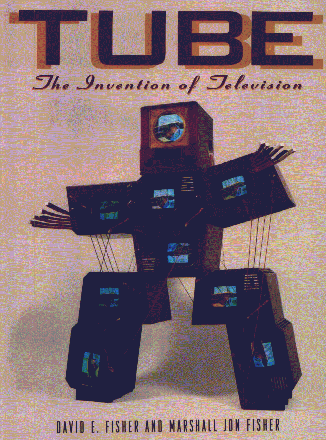NEWS RELEASE: New Book
TUBE
The Invention of Television
By David E. Fisher and Marshall Jon Fisher

Note
from John Dilks, NJARC Web Editor: This is the best historical book to
come out in a long time. I planned to (and still do) write "A Radioman's
Review of a Television Book." In the mean time, the information in
this book is too good to sit on while I read the entire book, then write
the report. Hence, I am publishing their News Release for your information.
Tube: The Invention of Television is
technicial and historical in nature, conversationally written and easy
to understand. Almost every page is noted and the bibliography they used
is truly impressive. This book is a must for every collector and historian
of radio and television and anyone else interested in the industry. -ED.
"The genius of several individuals
coalesced into today's modern TV. In this personality-driven book, the
authors look at the key players and their contributions.... An engrossing,
in-depth look at the history of the medium." - Publishers
Weekly
Who invented television? Surprisingly, most people don't know.
Every school child knows the Wright brothers invented the airplane and
Alexander Graham Bell the telephone. Marconi invented the radio and Edison
the electric light, but ask someone who invented television, and the question
will probably be greeted by silence.
Fifty years after television's commercial debut, Counterpoint has published
Tube: The Invention of Television [$30]. Part of the Alfred
P. Sloan Foundation's Technology Series, Tube presents the
turbulent history of one of the most important-most beloved and most reviled-inventions
of the twentieth century.
The invention of television was not like the invention of the atomic bomb,
which came with a flash of insight followed by experimentation. There was
no sudden moment of victory, as with the Wright brothers' first flight.
Instead, television was an elusive, tantalizing dream. It took the greatest
scientists of the day a long time to make a working prototype, and then
it took them longer to perfect it. From the first seed of possibility in
1872 to the TV boom of the 1960s, the race to invent television was filled
with little triumphs and devastating failures. Fortunes were made and lost,
lives buoyed and wrecked. Divisive battles over patents, broadcasting standards,
and color technology raged continuously. World events -WWI, the Depression,
WWII, the Korean War- postponed developments at critical moments. And,
perhaps most frustrating, the technology itself remained just out of grasp
for decades.
An anecdotal history that reads like an adventure story, Tube
follows the competing and criss-crossing lives of television's primary
inventors:
John Logie Baird, the eccentric Scot who created the first mechanical
prototype of television. His earlier inventions-the Baird Under-Sock and
the glass rustless razor-met with limited success, but he enjoyed fame
and fortune with his televisor. He ignored new technology, however,
and watched his dream disappear in the realization of an all-electronic
system.
Philo T. Farnsworth, the Idaho farm boy who visualized the first
electronic model for television when he was fourteen years old. By the
time he was twenty, he'd found private funding and built his model. The
youngest and most ambitious of the "lone" inventors, he would
nevertheless be defeated by the powerful RCA.
Vladimir Zworykin, the scientist who paved the way for RCA. His
electronic system lacked some of the finesse of Farnsworth's model, but
his genius, combined with RCA's backing, would prove unstoppable.
There were others. Ernst Alexanderson, the scientist who lost
out to Zworykin at RCA. Charles Jenkins, whose broadcasting business
(one of the first) died in the Depression. And of course, David Sarnoff,
the RCA executive who ruthlessly molded TV into the commercially viable
household commodity we know today. In the end, none of them could claim
the title 'inventor of television,' for it came into being gradually, through
all of their efforts combined.
Tube concludes with a look at the future of television
in the digital age. Over the next ten to fifteen years, the American public
will increasingly receive television programs as digital signals, collapsing
the separation between television and the Internet. With this great metamorphosis
approaching, it is a particularly good time to look back at television's
past. Tube will tell the MTV generation, if anything can,
the story behind the device that has shaped them. It will explain to the
nonscientist how television actually works, and it will tell us all about
the men who devoted their lives to inventing it and who deserve greater
fame.
David E. Fisher, an author celebrated for his ability to make science
understandable, and his son Marshall
Jon Fisher, have created a book that is more than the history of
an invention. It is a compelling story of eccentric personalities, exciting
times, unbridled genius and greed. What did you expect? After all, this
is TV. Click here for more information
about the authors.
Tube: The Invention of Television
September 30, 1996.
ISBN 1-887178-17-I
6 x 9" 448 pages, plus l6 page photo insert: $30.00
Available in most major book stores
or order via the Internet:
Bookseller: http://www.amazon.com
(Search on the title: Tube:
The Invention of Television )
or order direct from the publisher:
Counterpoint
1627 I Street NW, Suite 850
Washington, DC 20006
tel: 202-887-0363
fax: 202-887-0562
|
Cover art by Nam June Paik, John Cage Robot (1990),
courtesy Carl Solway Gallery. Photographer: Chris Gomien.
|
Return to NJARC HomePage
